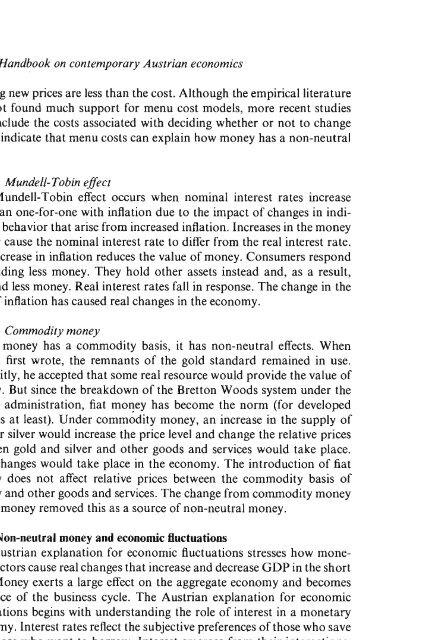Handbook on Contemporary Austrian Economics
Handbook on Contemporary Austrian Economics
Handbook on Contemporary Austrian Economics
You also want an ePaper? Increase the reach of your titles
YUMPU automatically turns print PDFs into web optimized ePapers that Google loves.
118 <str<strong>on</strong>g>Handbook</str<strong>on</strong>g> <strong>on</strong> c<strong>on</strong>temporary <strong>Austrian</strong> ec<strong>on</strong>omics<br />
posting new prices are less than the cost. Although the empirical literature<br />
has not found much support for menu cost models, more recent studies<br />
that include the costs associated with deciding whether or not to change<br />
prices indicate that menu costs can explain how m<strong>on</strong>ey has a n<strong>on</strong>-neutral<br />
effect.<br />
8.3.5 Mundell-Tobin effect<br />
The Mundell-Tobin effect occurs when nominal interest rates increase<br />
less than <strong>on</strong>e-for-<strong>on</strong>e with inflati<strong>on</strong> due to the impact of changes in individual<br />
behavior that arise from increased inflati<strong>on</strong>. Increases in the m<strong>on</strong>ey<br />
supply cause the nominal interest rate to differ from the real interest rate.<br />
The increase in inflati<strong>on</strong> reduces the value of m<strong>on</strong>ey. C<strong>on</strong>sumers resp<strong>on</strong>d<br />
by holding less m<strong>on</strong>ey. They hold other assets instead and, as a result,<br />
demand less m<strong>on</strong>ey. Real interest rates fall in resp<strong>on</strong>se. The change in the<br />
rate of inflati<strong>on</strong> has caused real changes in the ec<strong>on</strong>omy.<br />
8.3.6 Commodity m<strong>on</strong>ey<br />
When m<strong>on</strong>ey has a commodity basis, it has n<strong>on</strong>-neutral effects. When<br />
Hayek first wrote, the remnants of the gold standard remained in use.<br />
Implicitly, he accepted that some real resource would provide the value of<br />
m<strong>on</strong>ey. But since the breakdown of the Brett<strong>on</strong> Woods system under the<br />
Nix<strong>on</strong> administrati<strong>on</strong>, fiat mo~ey has become the norm (for developed<br />
nati<strong>on</strong>s at least). Under commodity m<strong>on</strong>ey, an increase in the supply of<br />
gold or silver would increase the price level and change the relative prices<br />
between gold and silver and other goods and services would take place.<br />
Real changes would take place in the ec<strong>on</strong>omy. The introducti<strong>on</strong> of fiat<br />
m<strong>on</strong>ey does not affect relative prices between the commodity basis of<br />
m<strong>on</strong>ey and other goods and services. The change from commodity m<strong>on</strong>ey<br />
to fiat m<strong>on</strong>ey removed this as a source of n<strong>on</strong>-neutral m<strong>on</strong>ey.<br />
8.4 N<strong>on</strong>-neutral m<strong>on</strong>ey and ec<strong>on</strong>omic fluctuati<strong>on</strong>s<br />
The <strong>Austrian</strong> explanati<strong>on</strong> for ec<strong>on</strong>omic fluctuati<strong>on</strong>s stresses how m<strong>on</strong>etary<br />
factors cause real changes that increase and decrease GDP in the short<br />
run. M<strong>on</strong>ey exerts a large effect <strong>on</strong> the aggregate ec<strong>on</strong>omy and becomes<br />
a source of the business cycle. The <strong>Austrian</strong> explanati<strong>on</strong> for ec<strong>on</strong>omic<br />
fluctuati<strong>on</strong>s begins with understanding the role of interest in a m<strong>on</strong>etary<br />
ec<strong>on</strong>omy. Interest rates reflect the subjective preferences of those who save<br />
and those who want to borrow. Interest emerges from their interacti<strong>on</strong>s.<br />
Assume that intertemporal preferences do not change. That is, the interest<br />
rate does not change because people have altered their preferred trade-off<br />
between present and future c<strong>on</strong>sumpti<strong>on</strong>. This is the natural rate of interest.<br />
It is natural in the sense that it reflects the preferences and c<strong>on</strong>straints

















